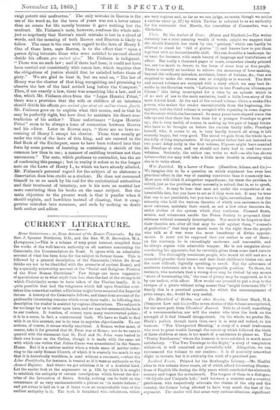CURRENT LITERATURE.
Roma Sotterranea ; or, Some Account of the Roman Catacombs. By the Rev. J. Spencer Northcote, D.D., and the Rev. W. B. Brownlow, M.A. (Longmans.)—This is a volume of very great interest, compiled from the works of the well-known authority on all matters concerning the Catacombs, the Commendatore de Rossi. It opens with an admirable account of what has been done for the subject in former times. This is followed by a general description of the Catacombs (which De Rossi thinks are not to be identified with the arenarias of ancient Rome), and by a specially noteworthy account of the "Social and Religious Position of the First Roman Christians." Few things are more suggestive of speculations as to what might have been than the fact of the strong hold which Christianity seems to have taken of the Flavian family. It is quite possible that had the vengeance which fell upon Domitian over- taken him somewhat earlier, a Christian might have mounted the Imperial throne. A history of the Catacombs follows, and there is an account of the profoundly interesting remains which cover their walls ; in following this description the reader is assisted by copious illustrations. The subject is far too large for us to enter upon here, and we can but commend the book to our readers. It touches, of course, upon many controverted points ; it is in a sense, in fact, a controversial book. We have no fault to find with it on this account, nor is its tone in anywise objectionable. To our notions, of course, it seems wholly uncritical. A Roman writer must, of course, take it for granted that St. Peter was at Rome ; nor do we care to quarrel with the statement that St. Paul and St. John were buried in their own house on the Cadian, though it is made with the samo air with which one writes that Julius Caner was assassinated in the Senate House. But it is a serious matter when a whole mass of matter refer- ring to the early Roman Church, of which it is scarcely too much to say that it is historically worthless, is used without a comment,—when the Lifer Pontificalis, for instance, is treated as if it were as authentic as the Annual Register. And where we get criticism it is of a doubtful kind. Let the reader look at the arguments on p. 133, by which it is sought to establish the antiquity of certain inscriptions which favour the doc- trine of the Invocation of Saints. Surely, nothing can be built on the occurrence of so very uncharacteristic a phrase as "in mento habere ;" and yet stress is laid on it as if there were an unmistakable tone of the earliest antiquity in it. The book is furnished with references, which are very copious and, as far as we oau judge, accurate, though we notice a curious error (p. 37) by which Tacitus is referred to as an authority for the statement that Marcia, the concubine of Commodus, was a Christian.


































 Previous page
Previous page